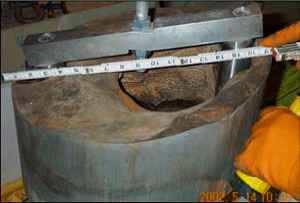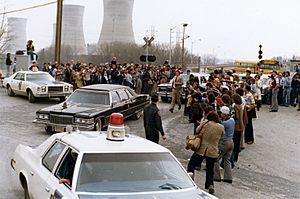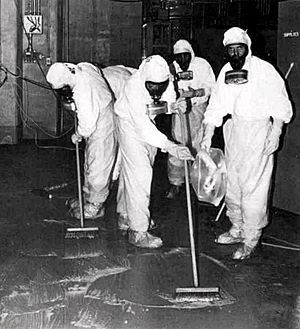Nuclear reactor accidents in the United States facts for kids

In the United States, there have been at least 56 accidents at nuclear reactors since 1952. These are incidents that caused either loss of life or more than $50,000 in property damage. The most serious accident was the Three Mile Island accident in 1979. The Davis-Besse Nuclear Plant has had two of the five most dangerous nuclear incidents in the U.S. since 1979. Luckily, very few of these accidents have caused deaths.
Contents
What are Nuclear Reactor Accidents?
Around the world, there have been at least 99 nuclear reactor accidents between 1952 and 2009. These accidents caused about $20.5 billion in property damage. Accidents can involve things like meltdowns, explosions, fires, or losing the cooling water. They can happen during normal operations or during emergencies like earthquakes. The costs include fixing damage, emergency help, cleaning up the environment, and other expenses. Because nuclear reactors are very large and complex, accidents can be quite expensive.
In the U.S., more than 56 nuclear reactor accidents have happened. The Three Mile Island accident in 1979 was the most serious one. The Nuclear Regulatory Commission says that the Davis–Besse Nuclear Power Station has been involved in two of the top five most dangerous nuclear incidents in the U.S. since 1979.
The United States Government Accountability Office reported over 150 incidents from 2001 to 2006 where nuclear plants did not meet safety rules. They said that over 75% of operating plants had extra safety checks for a while.
A Brief History of Nuclear Safety
The Atomic Energy Act of 1954 encouraged private companies in the U.S. to build nuclear reactors. This was a new area, and there were many early accidents at test reactors. Because of these risks, the Price-Anderson Act was created in 1957. This law helped protect companies from huge costs if an accident happened.
Nuclear accidents continued into the 1960s. In January 1961, a small test reactor called Stationary Low-Power Reactor Number One exploded in Idaho Falls. Three people died, which were the first deaths in U.S. nuclear reactor operations. There was also a partial meltdown at the Enrico Fermi Nuclear Generating Station in Michigan in 1966.
As nuclear reactors became larger in the late 1960s, new safety questions came up. People worried about a serious accident releasing a lot of radiation. In the early 1970s, there was a big debate about emergency cooling systems. These systems are designed to stop a core meltdown, which is sometimes called the "China syndrome".
In 1976, four nuclear engineers, including three from GE, resigned. They said that nuclear power was not as safe as their bosses claimed. They told a government committee that a nuclear power plant accident was "a certain event." They believed it was only a matter of "when, and where."
The Three Mile Island Accident

On March 28, 1979, a serious accident happened at the Three Mile Island Nuclear Power Plant in Pennsylvania. Equipment failed, and human errors led to a loss of cooling water. This caused a partial meltdown of the reactor's core. It took five days for officials to understand how serious and complex the accident was. They had to decide if people needed to be evacuated.
The cleanup of the plant began in August 1979 and finished in December 1993. It cost about $1 billion. One expert, Benjamin K. Sovacool, estimated the total property damage from the accident was $2.4 billion. Most experts agree that the health effects on people from the Three Mile Island accident were very small.
The Three Mile Island accident forced the nuclear industry to make many safety improvements. However, it also increased opposition to nuclear power. Protests against nuclear power happened all over the world after this event.
List of Accidents and Incidents in the U.S.
| Date | Location | Description | Fatalities | Cost (in millions 2006 US$) |
INES rating |
|---|---|---|---|---|---|
| November 29, 1955 | Idaho Falls, Idaho, US | Power surge with partial core meltdown at National Reactor Testing Station's EBR-1 Experimental Breeder Reactor I | 0 | 5 | |
| July 26, 1959 | Simi Valley, California, USA | Partial core meltdown at Santa Susana Field Laboratory's Sodium Reactor Experiment | 0 | 32 | |
| January 3, 1961 | Idaho Falls, Idaho, US | Steam explosion and meltdown caused three deaths at National Reactor Testing Station's SL-1 Stationary Low-Power Reactor Number One | 3 | 22 | 4 |
| July 24, 1964 | Charlestown, Rhode Island, USA | A worker's error at a fuel facility led to an accidental criticality (a chain reaction) | 1 | ?? | |
| October 5, 1966 | Monroe, Michigan, USA | Sodium cooling system failed at Enrico Fermi reactor, causing partial core meltdown | 0 | 19 | |
| July 16, 1971 | Cordova, Illinois, USA | An electrician was electrocuted by a live cable at the Quad Cities Unit 1 reactor | 1 | 1 | |
| August 11, 1973 | Covert Township, Michigan, USA | Steam generator leak at the Palisades Nuclear Generating Station caused a manual shutdown | 0 | 10 | |
| March 22, 1975 | Athens, Alabama, USA | Fire burned for seven hours at Browns Ferry, damaging control cables and disabling cooling systems | 0 | 240 | |
| November 5, 1975 | Brownville, Nebraska, USA | Hydrogen gas explosion damaged the Cooper Nuclear Facility's auxiliary building | 0 | 13 | |
| June 10, 1977 | Waterford, Connecticut, USA | Hydrogen gas explosion damaged three buildings and forced shutdown of Millstone-1 reactor | 0 | 15 | |
| March 28, 1979 | Middletown, Pennsylvania, US | Loss of coolant and partial core meltdown, see Three Mile Island accident | 0 | 2,400 | 5 |
| November 22, 1980 | San Clemente, California, USA | Worker electrocuted at San Onofre Pressurized Water Reactor | 1 | 1 | |
| January 25, 1982 | Ontario, New York, USA | Ginna Nuclear Generating Station had a steam tube rupture, releasing radioactivity | 0 | 1 | |
| March 20, 1982 | Scriba, New York, USA | Piping failed at Nine Mile Point Unit 1, forcing a two-year shutdown | 0 | 45 | |
| March 25, 1982 | Buchanan, New York, USA | Damage to steam generator tubes at Indian Point Energy Center Unit 3 caused a shutdown for over a year | 0 | 56 | |
| February 12, 1983 | Forked River, New Jersey, USA | Oyster Creek Nuclear Generating Station failed safety inspection, forced to shut down for repairs | 0 | 32 | |
| February 26, 1983 | Fort Pierce, Florida, USA | Damaged thermal shield at St. Lucie Unit 1 needed a 13-month shutdown | 0 | 54 | |
| September 15, 1984 | Athens, Alabama, US | Safety violations and errors forced a six-year shutdown at Browns Ferry Unit 2 | 0 | 110 | |
| March 9, 1985 | Athens, Alabama, US | Instrument malfunctions during start-up led to all three Browns Ferry Units being shut down | 0 | 1,830 | |
| June 9, 1985 | Oak Harbor, Ohio, US | Loss of feedwater at Davis-Besse reactor due to operator error. A site area emergency should have been declared. | 0 | ? | |
| April 11, 1986 | Plymouth, Massachusetts, US | Equipment problems forced emergency shutdown of Pilgrim Nuclear Power Plant | 0 | 1,001 | |
| December 9, 1986 | Surry, Virginia, USA | Feedwater line burst at Surry Nuclear Power Plant killed 4 people | 4 | ||
| March 31, 1987 | Delta, Pennsylvania, US | Peach Bottom units 2 and 3 shut down due to cooling problems | 0 | 400 | |
| July 15, 1987 | Burlington, Kansas, USA | Safety inspector died from electrocution at Wolf Creek Nuclear Generating Station | 1 | 1 | |
| December 19, 1987 | Scriba, New York, US | Malfunctions forced Nine Mile Point Unit 1 to shut down | 0 | 150 | |
| March 29, 1988 | Burlington, Kansas, USA | A worker at Wolf Creek Generating Station fell through an unmarked manhole and was electrocuted | 1 | 1 | |
| March 5, 1989 | Tonopah, Arizona, USA | Dump valves failed at Palo Verde Unit 1, leading to a transformer fire | 0 | 14 | |
| March 17, 1989 | Lusby, Maryland, US | Inspections at Calvert Cliff Units 1 and 2 found cracks, forcing long shutdowns | 0 | 120 | |
| November 17, 1991 | Scriba, New York, USA | Safety and fire problems forced shutdown of the FitzPatrick nuclear reactor for 13 months | 0 | 5 | |
| April 21, 1992 | Southport, North Carolina, USA | NRC forced shutdown of Brunswick Units 1 and 2 after emergency diesel generators failed | 0 | 2 | |
| February 3, 1993 | Bay City, Texas, USA | Auxiliary feed-water pumps failed at South Texas Project Units 1 and 2, causing both reactors to shut down quickly | 0 | 3 | |
| February 27, 1993 | Buchanan, New York, USA | New York Power Authority shut down Indian Point Energy Center Unit 3 after a safety system failed | 0 | 2 | |
| March 2, 1993 | Soddy-Daisy, Tennessee, USA | Equipment failures and broken pipes caused shutdown of Sequoyah Unit 1 | 0 | 3 | |
| December 25, 1993 | Newport, Michigan, USA | Fermi Unit 2 shut down after a major turbine failure due to poor maintenance | 0 | 67 | |
| January 14, 1995 | Wiscasset, Maine, USA | Steam generator tubes cracked at Maine Yankee nuclear reactor, leading to a year-long shutdown | 0 | 62 | |
| May 16, 1995 | Salem, New Jersey, USA | Ventilation systems failed at Salem Units 1 and 2 | 0 | 34 | |
| February 20, 1996 | Waterford, Connecticut, US | Leaking valve forced shutdown of Millstone Nuclear Power Plant Units 1 and 2, and many equipment failures were found | 0 | 254 | |
| May 15, 1996 | Morris, Illinois, US | Low water levels around the nuclear fuel in the reactor's core caused shutdown at Dresden Generating Station | 0 | ? | |
| September 2, 1996 | Crystal River, Florida, US | Equipment malfunction forced shutdown and repairs at Crystal River Unit 3 | 0 | 384 | |
| September 5, 1996 | Clinton, Illinois, USA | Reactor pump failed, causing shutdown of Clinton boiling water reactor | 0 | 38 | |
| September 20, 1996 | Seneca, Illinois, USA | Service water system failed, leading to closure of LaSalle Units 1 and 2 for over 2 years | 0 | 71 | |
| September 9, 1997 | Bridgman, Michigan, USA | Ice condenser containment systems failed at Cook Units 1 and 2 | 0 | 11 | |
| May 25, 1999 | Waterford, Connecticut, USA | Steam leak caused manual shutdown and damage at the Millstone Nuclear Power Plant | 0 | 7 | |
| September 29, 1999 | Lower Alloways Creek Township, New Jersey, USA | Major Freon leak at Hope Creek Nuclear Generating Station released toxic gas and damaged the cooling system | 0 | 2 | |
| February 15, 2000 | Buchanan, New York, USA | NRC Alert issued after steam tube rupture at Indian Point Unit 2 | 0 | 2 | |
| February 16, 2002 | Oak Harbor, Ohio, US | Severe corrosion of reactor head forced a 24-month shutdown of Davis-Besse reactor | 0 | 605 | 3 |
| January 15, 2003 | Bridgman, Michigan, USA | A fault in the main transformer at the Donald C. Cook Nuclear Generating Station caused a fire | 0 | 10 | |
| June 16, 2005 | Braidwood, Illinois, USA | Exelon's Braidwood nuclear station leaked tritium, contaminating local water | 0 | 41 | |
| August 4, 2005 | Buchanan, New York, USA | Entergy's Indian Point Nuclear Plant leaked tritium and strontium into underground lakes from 1974 to 2005 | 30 | ||
| March 6, 2006 | Erwin, Tennessee, USA | Nuclear Fuel Services plant spilled 35 liters of highly enriched uranium, needing a 7-month shutdown | 0 | 98 | |
| September, 2009 | Crystal River, Florida, USA | Cutting into Crystal River 3 Nuclear Power Plant caused severe cracks, leading to its permanent closure | 0 | 1,000+ | |
| February 1, 2010 | Vernon, Vermont, US | Leaking underground pipes from the Vermont Yankee Nuclear Power Plant released radioactive tritium into groundwater | 0 | 700 | |
| July 15, 2011 | Morris, Illinois, US | Chemical leak of sodium hypochlorite limited access to vital cooling water pumps at Dresden Generating Station | 0 | ? | |
| January 30, 2012 | Byron, Illinois, US | An unusual incident at Byron Nuclear Generating Station led to a loss of power and safety functions until operators manually fixed it. This showed a design flaw in many U.S. reactors. | 0 | Undetermined | |
| March 31, 2013 | Russellville, Arkansas, US | One worker was killed and two injured when part of a generator fell at the Arkansas Nuclear One plant. | 1 | ? | |
| July 2016 | Bridgman, Michigan, US | Heavy steam leak into the turbine building of D.C. Cook Nuclear Station | 0 | ? | |
| July 2018 | Genoa, Wisconsin, US | La Crosse Boiling Water Reactor Deconstruction leak into Mississippi River | 0 | ? |
Keeping Nuclear Power Safe

Nuclear safety in the U.S. is managed by federal rules from the Nuclear Regulatory Commission (NRC). The NRC oversees all nuclear plants and materials in the U.S., except for those controlled by the U.S. government or used in naval ships.
The Three Mile Island accident in 1979 was a very important event that made people question U.S. nuclear safety. Other events also had a similar effect. These included a 1975 fire at Browns Ferry and the warnings from three concerned GE nuclear engineers in 1976, known as the GE Three. In 1981, workers accidentally put pipe restraints on backward at the Diablo Canyon Power Plant. This mistake affected earthquake protection systems. All these well-known events made the public less supportive of the U.S. nuclear industry in the 1970s and 1980s.
Recently, there have been new worries about reactor safety. In 2012, the Union of Concerned Scientists reported that "leakage of radioactive materials is a widespread problem at almost 90 percent of all reactors." They also noted other issues that could lead to nuclear accidents.
After the Fukushima Daiichi nuclear disaster in Japan, a survey of U.S. electric utility executives showed that nuclear safety was their top concern. There will likely be stricter rules for storing used nuclear fuel at plants. Also, licenses for older reactors might be checked again. Some licenses already given to over 60 of the 104 operating U.S. reactors could be reviewed. How spent fuel is stored will probably be looked at again because of what happened at Fukushima.
In October 2011, the Nuclear Regulatory Commission decided to move forward with seven of 12 safety suggestions. These suggestions include "new standards to help operators deal with a complete loss of power." They also aim to make sure plants can handle floods and earthquakes. And they want to improve how quickly emergency teams can respond. These new safety standards will take up to five years to fully put into place.
See also
 In Spanish: Accidentes de reactores nucleares en Estados Unidos para niños
In Spanish: Accidentes de reactores nucleares en Estados Unidos para niños

